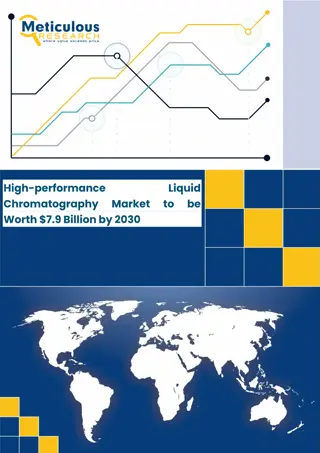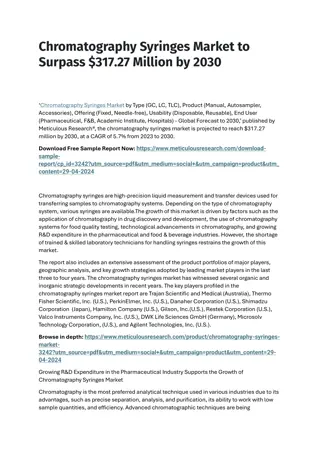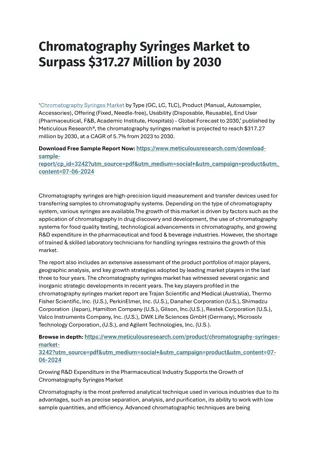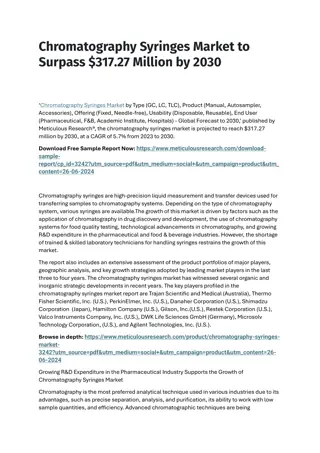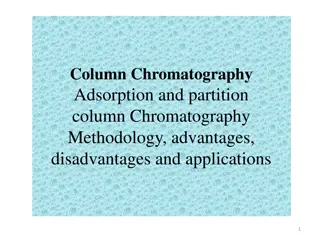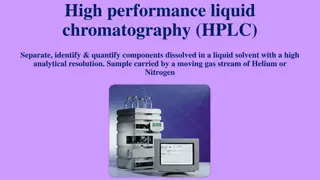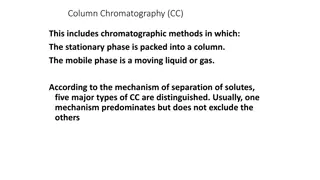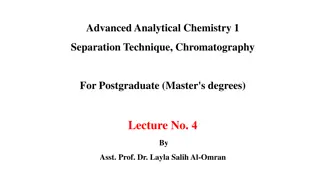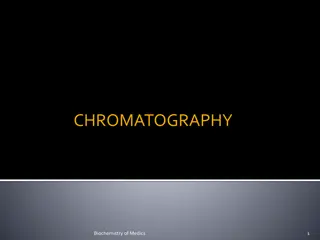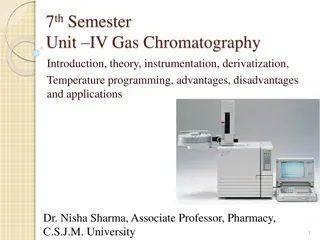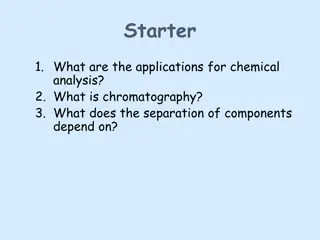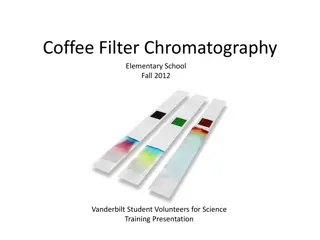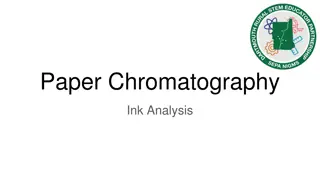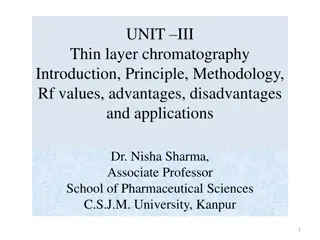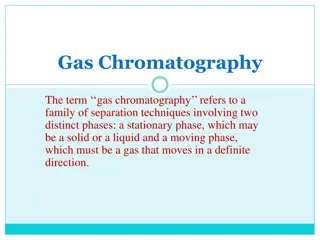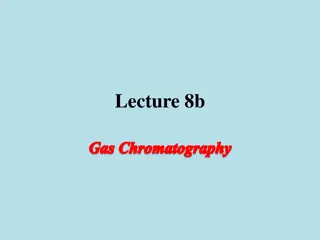Understanding HPLC: A Powerful Liquid Chromatography Technique
High-performance liquid chromatography (HPLC) is a powerful tool in analysis, offering high performance and speed compared to traditional chromatography methods. It involves separating components through a stationary phase and mobile phase, utilizing adsorption principles for separation. HPLC is widely used in biochemistry and analytical chemistry to identify, quantify, and purify individual compounds within a mixture.
Download Presentation

Please find below an Image/Link to download the presentation.
The content on the website is provided AS IS for your information and personal use only. It may not be sold, licensed, or shared on other websites without obtaining consent from the author. Download presentation by click this link. If you encounter any issues during the download, it is possible that the publisher has removed the file from their server.
E N D
Presentation Transcript
INTRODUCTION HPLC stands for High-performance liquid chromatography (sometimes referred to as High- pressure liquid chromatography). High performance liquid chromatography is a powerful tool in analysis, it yields high performance and high speed compared to traditional columns chromatography because of the forcibly pumped mobile phase. HPLC is a chromatographic technique that can separate a mixture of compounds It is used in biochemistry and analytical chemistry to identify, quantify and purify the individual components of a mixture.
Chromatography : physical method in which separation of components takes place between two phases-a stationary phase and a mobile phase Stationary phase : The substance on which adsorption of the analyte (the substance to be separated during chromatography) takes place . It can be a solid, a gel, or a solid liquid combination Mobile phase : solvent which carries the analyte (a liquid or a gas)
HPLC is a type of liquid chromatography where the sample is forced through a column that is packed with a stationary phase composed of irregularly or spherically shaped particles, a porous monolithic layer , or a porous membrane by a liquid (mobile phase) at high pressure.
PRINCILPE The main principle of separation in normal phase mode and reverse phase mode is adsorption. When a mixture of components are introduced into the column. various chemical and/or physical interactions take place between the sample molecules and the particles of the column packing . They travel according to their relative affinities towards the stationary phase. The component which has more affinity towards the adsorbent, travels slower. The component which has less affinity towards the stationary phase travels faster. Since no two components have the same affinity towards the stationary phase, the components are separated
HPLC is a separation technique that involves: the injection of a small volume of liquid sample into a tube packed with tiny particles (3 to 5 micron ( m) in diameter called the stationary phase) where individual components of the sample are moved down the packed tube (column) with a liquid (mobile phase) forced through the column by high pressure delivered by a pump.
These components are separated from one another by the column packing that involves various chemical and/or physical interactions between their molecules and the packing particles. These separated components are detected at the exit of this tube (column) by a flow-through device (detector) that measures their amount. The output from the detector is called a liquid chromatogram In principle, LC and HPLC work the same way except the speed , efficiency, sensitivity and ease of operation of HPLC is vastly superior .
TYPES OF HPLC I.BASED ON MODE OF SEPERATION 2 TYPES : Normal and Reverse phase. These modes are based on the polarity of stationary and mobile phase. 1.Normal phase chromatography - stationary phase (Silica gel ) is polar (hydrophilic) and mobile phase is non-polar (hydrophobic). In this technique non-polar compounds are travels faster & eluted first. This is because less afinity between solute & stationary phase. Polar compounds are retained for longer time in column bcoz more affinity towards the stationary phase & it takes more time to be eluted from the column. This is nt advantageous in pharmacy since most of the drug & molecules r polar in nature & it takes long time be eluted & detected. So it is not widely used in pharmacy. 2.Reverse phase chromatography- stationary phase is non-polar (hydrophobic) and mobile phase is Polar (hydrophilic) in nature. Hence polar components get eluted first & non-polar compounds are retained for longer time. Since most of the drugs & Pharmaceuticals are polar in nature , they are not retained for a longer time & eluted firster. Different types of colums are used i.e ODS ( Octadecyl silane ) or C18 , C4 . e.t.c. Polar-Polar bonds and Non Polar-Non Polar bonds have more affinity than Polar-Non Polar bonds. Reverse phase chromatography is more commonly used as drugs are usually hydrophilic
II.BASED ON PRINCIPLE OF SEPERATION 1.Adsorption Chromatography In the Adsorption Chromatography solute molecules bond directly to the surface of the stationary phase the component which has more affinity towards mobile phase elutes first & the component which has less affinity towards stationary phase elutes later. No two components have same affinity towards mobile phase & stationary phase.
2. Ion-exchange chromatography Ion exchange chromatography is a process that allows the separation of ions and polar molecules based on their charge. It can be used for almost any kind of charged molecule including large proteins, small nucleotides and amino acids. Retention is based on the attraction between solute ions and charged sites bound to the stationary phase. Ions of the same charge are excluded. The use of a resin (the stationary solid phase) is used to covalently attach anions or cat ions onto it. Solute ions of the opposite charge in the mobile liquid phase are attracted to the resin by electrostatic forces. .
3.Ion-pair chromatography It is a form of chromatography in which ions in solution can be "paired" or neutralized and separated as an ion pair on a reversed-phase column. Ion-pairing agents are usually ionic compounds that contain a hydrocarbon chain that imparts a certain hydrophobacity so that the ion pair can be retained on a reversed-phase column. 4. gel permeation chromatography This type of chromatography lacks an attractive interaction between the stationary phase and solute. The liquid or gaseous phase passes through a porous gel which separates the molecules according to its size.
The pores are normally small and exclude the larger solute molecules, but allows smaller molecules to enter the gel, causing them to flow through a larger volume. This causes the larger molecules to pass through the column at a faster rate than the smaller ones.
5.Affinity Chromatography This is the most selective type of chromatography employed. It utilizes the specific interaction between one kind of solute molecule and a second molecule that is immobilized on a stationary phase. For example, the immobilized molecule may be an antibody to some specific protein. When solute containing a mixture of proteins are passed by this molecule, only the specific protein is reacted to this antibody, binding it to the stationary phase. This protein is later extracted by changing the ionic strength or pH.
6.Chiral chromatography It involves the separation of stereoisomers. In the case of enantiomers, these have no chemical or physical differences apart from being three- dimensional mirror images. Conventional chromatography or other separation processes are incapable of separating them. To enable chiral separations to take place, either the mobile phase or the stationary phase must themselves be made chiral, giving differing affinities between the analytes.
III. BASED ON ELUTION TECHNIQUE 1.Isocratic elution A separation in which the mobile phase composition remains constant throughout the procedure is termed isocratic elution In isocratic elution, peak width increases with retention time linearly with the number of theoretical plates. This leads to the disadvantage that late-eluting peaks get very flat and broad. Best for simple separations Often used in quality control applications that support and are in close proximity to a manufacturing process
2. Gradient elution A separation in which the mobile phase composition is changed during the separation process is described as a gradient elution Gradient elution decreases the retention of the later-eluting components so that they elute faster, giving narrower peaks . This also improves the peak shape and the peak height Best for the analysis of complex samples Often used in method development for unknown mixtures Linear gradients are most popular
IV.BASED ON SCALE OF OPERATION 1.Analytical HPLC No recovery of individual components of substance 2.Preparative HPLC Individual components of substance can be recovered
V.BASED ON TYPE OF ANALYSIS 1.Qualitative analysis Analysis of a substance in order to ascertain the nature of its chemical constituents We can separate individual components but cannot assess the quantity in this analysis 2.Quantitaive analysis Determining the amounts and proportions of its chemical constituents . Quantity of the impurity and individual components can be assessed.
A . Solvent delivery system (mobile phase) The mobile phase in HPLC refers to the solvent being continuously applied to the column or (stationary phase) The mobile phase acts as a carrier to the sample solution A sample solution is injected into the mobile phase of an assay through the injector port. As a sample solution flows through a column with the mobile phase, the components of that solution migrate (moves) according to the non-covalent interaction of the compound with the column
The chemical interaction of the mobile phase and sample , with the column , determine the degree of migration and separation of components contained in the sample The solvents or mobile phases used must be passed through the column at high pressure at about 1000 to 3000 psi. this is because as the particle size of stationary phase is around 5-10 , so the resistance to the flow of solvent is high.
B. Pumps The role of the pump is to force a liquid (called the mobile phase) through the liquid chromatograph at a specific flow rate, expressed in milliliters per min (mL /min). Normal flow rates in HPLC are in the 1-to 2-mL/min range. Typical pumps can reach pressures in the range of 6000-9000 psi (400- to 600-bar). During the chromatographic experiment, a pump can deliver a constant mobile phase composition (isocratic) or an increasing mobile phase composition (gradient).
Types of HPLC pumps There are several types of pumps used for HPLC analysis, most commonly used are reciprocating piston pump,syringe pump and constant pressure pump 1.Reciprocating piston pumps: Consists of a small motor driven piston which moves rapidly back and forth in a hydraulic chamber that may vary from 35-400 L in volume On the back stroke , the separation column valve is closed , and the piston pulls in solvent from the mobile phase reservoir On the forward stroke,the pump pushes solvent out of the column from the reservoir A wide range of flow rates can be attained by altering the piston stroke volume during each cycle , or by altering the stroke frequency.
Dual and triple head pump consists of identical piston chamber units which operate at 180 or 120 degrees out of phase(this system is significantly smoother because one pump is filling while the other is in the delivery cycle.
2.Syringe type pump These are most suitable for small bore columns because this pump delivers only a finite volume of mobile phase before it has to be refilled. These pumps have a volume between 250 to 500mL The pump operates by a motorized lead screw that delivers mobile phase to the column at a constant rate .The rate of solvent delivery is controlled by changing the voltage on the motor.
3.Constant pressure pump In these types of pumps , the mobile phase is driven through the column with the use of pressure from the gas cylinder .A low-pressure gas source is needed to generate high liquid pressures The valving arrangement allows the rapid refill of the solvent chamber whose capacity is about 70mL This provides continuous phase flow rates
C. Injector: The injector serves to introduce the liquid sample into the flow stream of the mobile phase for analysis. It is equipped with six port valves so that a sample can be injected into the flow path at continuous pressure For a manual injector, the knob is manually operated to deliver the sample to the column The knob is set to LOAD position for sample injection using a syringe , the sample is injected into the sample loop , which is separated from the flow path The knob is turned to INJECT position and the eluent travels through the loop from the pump and delivers the sample to the column
Typical sample volumes for manual injector are 5-to 20-microliters ( L). The injector must also be able to withstand the high pressures of the liquid system. An autos ampler is the automatic version for when the user has many samples to analyze or when manual injection is not practical. It can continuously Inject variable volume a of 1 L 1 mL
D. Column Considered the heart of the chromatograph the column s stationary phase separates the sample components of interest using various physical and chemical parameters. It is usually made of stainless steel to withstand high pressure caused by the pump to move the mobile phase through the column packing other material include PEEK and glass The small particles inside the column are called the packing what cause the high back pressure at normal flow rates. Column packing is usually silica gel because of its particle shape , surface properties , and pore structure give us a good separation
Other material used include alumina, a polystyrene-divinyl benzene synthetic or an ion-exchange resin The dimensions of the analytical column are usually -straight, Length(5 ~ 25 cm), diameter of column(3 ~ 5 mm), diameter of particle(35 m). Number (40 k ~ 70 k plates/m)
Guard column is used to remove particular matter and contamination, it protect the analytical column and contains similar packing its temperature is controlled at < 150 C, 0.1 C E . Detector: The detector can detect the individual molecules that elute from the column and convert the data into an electrical signal A detector serves to measure the amount of those molecules The detector provides an output to a recorder or computer that results in the liquid chromatogram Detector is selected based on the analyte or the sample under detection
Commonly used detectors in HPLC Ultraviolet (UV) This type of detector responds to substances that absorb light. The UV detector is mainly to separate and identify the principal active components of a mixture. UV detectors are the most versatile, having the best sensitivity and linearity. UV detectors cannot be used for testing substances that are low in chromophores (colorless or virtually colorless) as they cannot absorb light at low range. They are cost-effective and popular and are widely used in industry
Fluorescence This is a specific detector that senses only those substances that emit light. This detector is popular for trace analysis in environmental science. As it is very sensitive, its response is only linear over a relatively limited concentration range. As there are not many elements that fluoresce, samples must be syntesized to make them detectable. Mass Spectrometry The mass spectrometry detector coupled with HPLC is called HPLC-MS. HPLC-MS is the most powerful detector, widely used in pharmaceutical laboratories and research and development. The principal benefit of HPLC-MS is that it is capable of analyzing and providing molecular identity of a wide range of components.
Refractive Index (RI) Detection The refractive index (RI) detector uses a monochromator and is one of the least sensitive LC detectors. This detector is extremely useful for detecting those compounds that are non-ionic, do not absorb ultraviolet light and do not fluoresce. e.g. sugar, alcohol, fatty acid and polymers.
F . Data processing unit (Computer) Frequently called the data system, the computer not only controls all the modules of the HPLC instrument but it takes the signal from the detector and uses it to determine the time of elution (retention time) of the sample components (qualitative analysis) and the amount of sample (quantitative analysis). The concentration of each detected component is calculated from the area or height of the corresponding peak and reported.
OPERATION Switch on instrument Check system set up Prime the pump Prepare the column
Set-up software(for system flushing) Software set up(for sample run) Sample injection Chromatograph data acquisition
Parameters Retention time (RT) In a chromatogram, different peaks correspond to different components of the separated mixture. Time elapsed between sample introduction and maximum of response, it is the characteristic time it takes for a particular analyte to pass through the system Time taken for the analyte to travel from the column inlet to the point of detection(maximum peak)
For assay the main peak(main component) is considered For purity test all the peaks are considered Area of peak A= height base/2 Peak area gives us the concentration of the analyte
2.Retention volume: 50% of the component from the column. It is the product of retention time and flow rate. Retention volume is the volume of carrier gas required to elute Retention volume = Retention time flow rate 3.Seperation factor: components to be separated. Separation factor is the ratio of partition coefficient of the two S=Ka/Kb=(tb-to)/(ta-to)
Where to = Retention time of unretained substance Ka, Kb = Partition coefficients of a, b ta, tb = Retention time of substance a, b If there is a big difference in partition coefficient between 2 compounds, the peaks are far apart and the separation factor is more. If the partition coefficient of 2 compounds are similar, then the peaks are closer and the separation factor is less.
4. Resolution: components and the base line separation achieved. Resolution is the measure of extent of separation of 2 Rs = 2 (Rt1-Rt2) / w1+w2 5. Height Equivalent to a Theoretical Plate (HETP): column where distribution of solute between stationary phase and mobile phase has attained equilibrium. It can also be called as a functional unit of the column. A theoretical plate is an imaginary or hypothetical unit of a A theoretical plate can be of any height, which describes the efficiency of separation. If HETP is less, the column is more efficient. If HETP is more, the column is less efficient. .
HETP = length of the column/ no. of theoretical plates HETP is given by Van deemter equation HETP = A+B/ u+Cu arises due to the packing of the column. Where A = Eddy diffusion term or multiple path diffusion which This can be minimized by uniformity of packing. B = Longitudinal diffusion term or molecular diffusion. C = Effect of mass transfer. u = flow rate or velocity of the mobile phase.
6. Efficiency: Efficiency of a column is expressed by the theoretical plates. n = 16 Rt2/ w2 Where n = no of theoretical plates Rt= retention time w = peak width at base Rt and w are measured in common units (cm or mm , min or sec ). No of theoretical plates Is high, the column is said to be highly efficient. For GLC, a value of 600/metre is sufficient. But in HPLC, high values like 40,000 to 70,000/ meter are recommended.
7. Asymmetry factor: and said to follow Gaussian distribution. But in practice due to some factors, the peak is not symmetrical and shows tailing or fronting. A chromatographic peak should be symmetrical about its centre avoided by using less quantity of sample. Tailing is due to more active adsorption sites and can be eliminated by support pretreatment. Fronting is due to saturation of stationary phase and can be Asymmetry factor (0.95 to 1.05) can be calculated by AF = b/a (b, a calculated by 5% or 10% of the peak height). Broad peaks occur due to the more conc. of sample, large injection volume, column deterioration. Ghost peaks occur due to the contamination of the column, compound from earlier injections.



